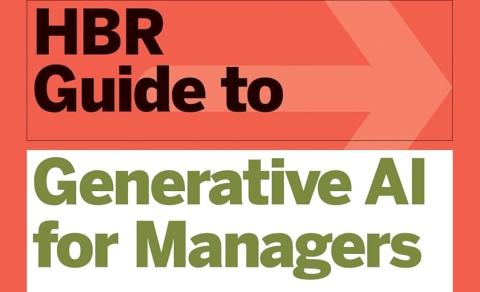HBR Guide to Generative AI for Managers
A recent online event organised by our colleagues at Harvard Business Review focused on the ‘HBR Guide to Generative AI for Managers’, a book that aims at helping managers to embrace the adoption of Gen AI and make it part of their daily work. At the moment, research shows a significant ‘knowing-doing gap’ where, even though 78% of managers recognise the potential of this tool, only 15% of them use it at least once a day.
When thinking about the use of new tools like Gen AI, we currently tend to associate them with boosting productivity and improving performance and we may mainly use them to carry out tasks like summarising documents, transcribing conversations and creating bullet point lists. In other words, we consider them productivity assistants in what the book calls a ‘co-pilot relationship’ aimed at increasing efficiency. This is a limited view of what Gen AI can actually do.
We should therefore explore how we can interact with AI differently to start looking at it as a co-thinker and a thought partner that, if used well, could help make decisions, solve problems, take different perspectives on things, and evaluate multiple options. In order to do so, we need to focus on 3 key components:
- a conversational mindset to create a collaborative relationship and a ‘two-way dialogue’ with AI;
- capability, intended as the ability to ask the appropriate questions to unlock its full potential, in the same way we would do with people;
- judgement, a key factor to understand that not all output is accurate and we therefore require our critical thinking to evaluate its validity and relevance.
More generally, we shouldn’t consider the process of AI adoption as a competition between AI and Humans, but instead a process of co-creation that benefits from an equal and complementary contribution from both parties involved. On one hand, AI can bring a wide range of information, ideas and options, it can help elaborate and articulate concepts, explore new perspectives and evaluate pros and cons in different scenarios. On the other, humans can bring the glue that brings it all together: the knowledge of specific contexts, the understanding of nuances (emotional and unspoken factors), the creation of counter arguments and the process of idea validation through critical thinking.
Even though it is evident that there still are significant challenges to overcome before developing a truly collaborative relationship with AI and we are still learning how to fully leverage its potential, the book proposes a four-step framework that could enable managers to use Gen AI across 4 management areas: self-management, team management, business management, and change management.
The essential takeaway from these discussions on how we adopt AI tools successfully is that AI shouldn’t be seen as something that will replace the human component but, on the contrary, it should be leveraged to augment our ability to do what we do even better.
*
Further reading on the topic:
Recently written by the authors of the book, this article provides a few insights on the content of the book and the four-step framework that the authors introduced to support managers in creating a collaborative relationship with Gen AI.
The Capgemini Research Institute also published the Gen AI at work: Shaping the future of organizations report that reflects on the significant impact that Gen AI may have on the future world of work and, more specifically, on the nature of new roles and responsibilities.
Valentina Lorenzon is a member of the CMCE Coordination group and editor of the CMCE newsletter.
